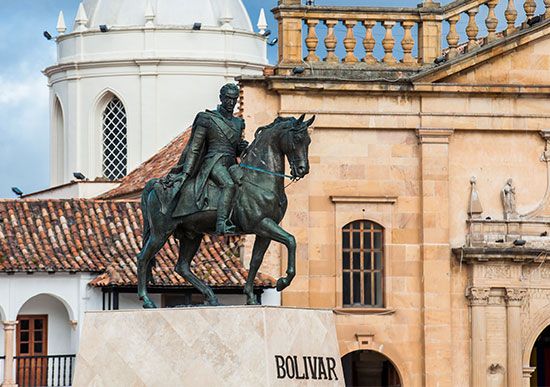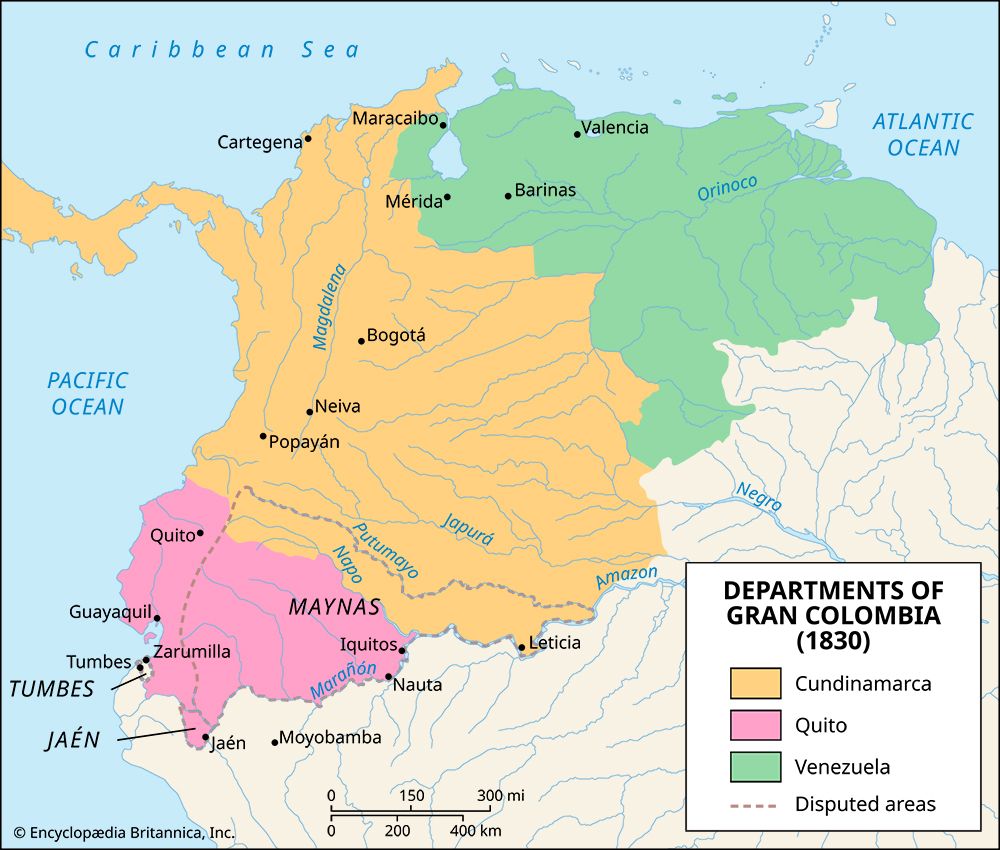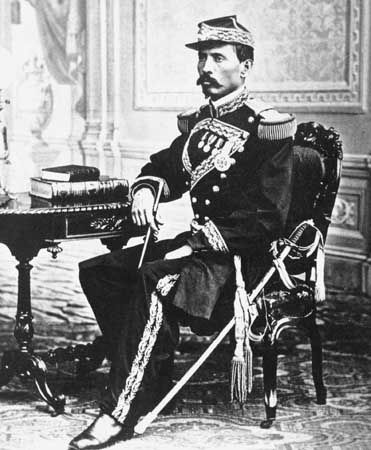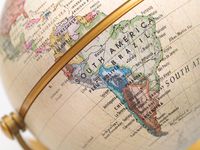The Spanish fringe
From the notion of “centre” as used above it follows that the remaining area of Spanish occupation was, from the Spanish point of view at least, peripheral. Most of the Hispanic territories in the Indies were occupied by groups coming precisely from the central areas. Conquering groups had always consisted largely of people of lesser position in the base area, and, as it grew clearer that the central areas were unequaled in their assets, the marginality of the personnel going elsewhere became even more pronounced. In addition to being new and uprooted, those who went to places like Chile, Tucumán (northwestern Argentina), or New Granada (Colombia) were likely to be estancieros and tratantes in the centre—not well-born, well-educated, or well-connected. Among them were a larger than average share of non-Spanish Europeans and free blacks. Since these movements were posterior to the initial conquests, the first Hispanics arriving often included some mulattoes and mestizos born in the centre.
Even so, the first Spanish groups in the peripheral areas were comparable to the first conquerors of the central areas in being of varied origins and commanding a variety of necessary skills. A greater difference showed itself later. The central-area conquerors, having struck it rich, sent out appeals to Spain that attracted huge numbers of people, especially male and female relatives, as well as fellow townspeople and others. Fringe-area conquerors had not struck it rich. They were less able to pay for the passage of relatives and less able to attract people in general. As a result, subsequent immigration to the periphery was a much thinner stream than to the centre and was sometimes nearly nonexistent for long periods of time, as in Paraguay, and many activities that were profitable in the centre were not viable. Hispanic society on the fringe was characterized then by its relatively small size, slow growth, and lack of characteristic signs of the centre indicating vigorous development—the presence of Spanish women, practicing Spanish artisans, and transatlantic merchants. The institutional overlay was a mere shadow of the complex network of the centre. The silver-mining sector was entirely absent, though some areas maintained gold production as a second-best (Chile for a substantial period and New Granada indefinitely and on quite a large scale).
From the above it is clear that society on the fringe was less differentiated than in the centre. Also, the encomenderos never rose very far above the rest. Here, the indigenous people hardly knew tribute, and their labour could not be turned into large revenue; moreover, there were far fewer of them. More Spanish intervention was needed, and yet there were not many Spaniards available. Encomenderos on the fringe usually lacked a large staff of majordomos and estancieros. Since the Indians of these regions were organized in much smaller units than those of the centre, many more encomiendas had to be granted among a much smaller number of Spaniards, so that the proportion of encomenderos was greater. Encomenderos and others had to fulfill several functions simultaneously.
When any of these societies began to prosper, however, sharper categorization reappeared, along with a general approximation of central-area patterns. Areas that in one way or another were equipped to supply regions on the trunk line (Guatemala, Venezuela, Chile, and northwestern Argentina) moved most quickly in that direction.
On the fringes, even in regions where it proved possible to establish some form of the encomienda, the relationship between Hispanic and indigenous societies was not the same as in the centre. In extreme cases, as in Paraguay, one can hardly speak of two separate worlds at all; there, in order to take advantage of the largest effective structure the indigenous people possessed—the extended household—the Spaniards actually entered into those households as heads. This led to a permanent indigenous influence on Spanish Paraguayan family structure, customs, diet, and language in a way and on a scale without parallel in the centre. Something of the same effect is observable even in situations where indigenous society was somewhat more like that of the centre, as in the central valley of Chile. The Spaniards dealt with the Indians directly, in small groups or as individuals, so that the distinction between encomienda Indians and naborías, so clear in the centre, hardly existed after a time.
Another effect of the nature of the more diffuse indigenous society was that in fringe areas the city, which in the centre was the stable bulwark of Hispanic society, was often notably unstable, shifting from one site to another because no location was predetermined by indigenous settlement. Similarly, rural church activity in the central areas was built squarely on existing territorial and sociopolitical units, using indigenous organization and customs. On the fringe the church for Indians, which here can be called a mission, was founded on a site more arbitrarily chosen, to which indigenous people were attracted, changing their settlement pattern and way of life. The late-arriving Jesuits, who had missed out in the ecclesiastical occupation of the hinterland in the central areas, took a large part in this movement, with especially prominent theatres of activity in the north of Mexico and in Paraguay. The fringe also saw of necessity the building of forts and the creation of standing military forces, paid, if poorly, by the royal government.
Interpenetration of the two societies occurred mainly when the Indians were semisedentary; where they were truly nonsedentary, another pattern emerged. Here the relationship between Spaniards and Indians was of long-standing hostility, with a minimum of social intercourse. Indigenous society remained quite radically separate from Hispanic as long as it survived, whereas the local Spanish societies, though often little developed, were more purely European than in any other kind of situation; the only indigenous people there were usually uprooted sedentary Indians from neighbouring regions. The far north of Mexico and the far south of Chile are two such areas.
In general, one notes a slow tempo on the fringe, with the result that eventually many forms on the periphery seem archaic. The fringe areas tended to maintain some form of the encomienda far into the 18th century, when it was forgotten in the centre; likewise Indian slavery, as well as parish activity among Indians by members of the religious orders, persisted indefinitely. The use of titles was conservative, and many of the social complexities evolving in the centre were slow to reach the periphery.
Brazil
The Treaty of Tordesillas (1494) between Spain and Portugal, dividing the non-European world between them, gave the Portuguese a legal claim to a large part of the area to be called Brazil. The Portuguese came upon the Brazilian coast in 1500 on the way to India and would doubtless have acted much as they did with or without the treaty. For decades Brazil was doubly a fringe area. In the Portuguese scheme, it was far behind longer-established and more profitable overseas ventures in Africa and India. In the context of the Western Hemisphere, it was an area lacking known large deposits of precious metals and possessing a semisedentary Tupian population similar and related to the Guaraní the Spaniards were to find in Paraguay; thus it had much in common with the Spanish-American periphery.
The early period
The Portuguese at first thought of Brazil as an area analogous to Africa—that is, an area on the route to India where they would stop for trade or barter in indigenous products and slaves but not establish permanent settlements beyond an occasional trading post. The most commercially viable resource of Brazil in the first decades proved to be the item that gave the country its name, brazilwood, a tropical hardwood useful as a textile dye. As with Africa, the Portuguese government let out contracts for the trade to private individuals.
The brazilwood industry did not bring about the founding of cities or other marks of full development, but its bulk was considerable for a time, and it was not a pure trade in natural products but involved some intervention on the part of the Portuguese. Though indigenous men of the region were accustomed to cutting down forest trees to clear fields, they did not have a tradition of commerce in trees, nor were they able to cut them on a large scale. The Portuguese therefore had to provide European axes and saws as well as product specifications. A Portuguese factor, or trading agent, would acquire the logs and have them ready when the ships came. Trading posts were often on islands, as in Africa, and a little later the first formal Portuguese settlements were also founded on islands. The only Portuguese who could be said to be actually settled in Brazil were some outcasts living among the Indians, who sometimes helped acquire useful Indian alliances.
About 1530 the Portuguese began to feel pressures to intensify their involvement with Brazil. Interlopers, especially the French, had begun to appear; the India trade was in a slump; and the great successes in Spanish America represented both an incentive and a threat. In response to such stimuli, the Portuguese sent an expedition to drive out the French and assert their authority. A number of settlers accompanied the expedition, which established the first formal Portuguese settlement—São Vicente—in 1532 on an island near present São Paulo.
The Portuguese had thus far acted entirely within their maritime-commercial tradition, and they continued for some time to do so, adopting measures quite different from those of the Spaniards. Whereas the Spaniards expanded from one area to the next in relay fashion, the Portuguese crown, in the mid-1530s, divided the entire Brazilian coast into strips of donatary captaincies, of which there were eventually 15. It granted them to donatários, prominent people presumed to have the personal resources to carry out the occupation and exploitation of their regions. The office was hereditary, with extensive judicial and administrative powers. The Portuguese had previously used this type of concession for their Atlantic island possessions. The encomienda, the master institution of 16th-century Spanish America, was not employed. From the first, though, leading Portuguese acquired large sesmarias, or land grants.
In the event, several of the captaincies were never occupied at all, and others survived only for a short time. However, four of them led to permanent settlements, and two of these, São Vicente in the south and Pernambuco in the north, proved distinctly viable and profitable.
As on much of the Spanish fringe, the first Portuguese settlements in Brazil had to be fortified against Indian attacks. Provisioning was difficult, and for a time the Portuguese got much of their food through trade with the indigenous people, becoming accustomed to manioc (cassava) as their staple rather than wheat, which grew poorly in much of the region. Two types of agricultural establishments emerged: roças, which were food farms or truck gardens near towns, and fazendas, or export enterprises. The last were mainly sugar plantations, which were not yet very prosperous, even though conditions for sugar growing and transport were ideal in many places, because of lack of capital to build mills and buy African slave labour. The Portuguese at first tried to extract labour from the indigenous people in exchange for European products, but the effort failed, in part because the men of these semisedentary societies were not accustomed to agricultural labour. As had happened in Spanish America, the Brazilian settlers soon turned to Indian slavery for workers; slaves were acquired through raiding or through purchase from other Indians. A minority of more expensive African slaves formed a labour elite, much as in Spanish America.
In 1548, still in response to much the same pressures and incentives as in 1530, the Portuguese decided to set up direct royal government in Brazil. The crown named a governor-general who took an expedition of a thousand people to Brazil, establishing a capital for the entire country in Bahia on the northeastern coast. In 1551 a bishopric was created. Thus it was not until 50 years after contact that Brazil achieved the level of institutionalization characteristic of the Spanish-American central areas almost from the beginning. The pace of development was much more comparable to that on the Spanish-American fringe.
At about this same time the Jesuits began to arrive, soon becoming the strongest arm of the church, as opposed to in Spanish America, where they arrived long after the other orders. They were prominent in the attempt to deal with the indigenous population, founding villages (aldeias) on new sites much in the manner of the missions on the Spanish-American fringe. Thus the main forms of European-Indian contact in Brazil—war, trade, slavery, and missions—were the same as on the periphery of Spanish America.
The Portuguese population in 16th-century Brazil remained sparse. Moreover, by all indications, including the Portuguese practice of exiling convicts to Brazil, one can imagine that it was as acutely marginal socially as were the settlers of Spanish-American fringe areas.





















